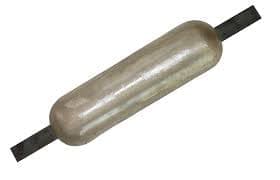Key Components of Sacrificial Anode Cathodic Protection Systems:
Sacrificial Anodes:
Typically made of highly active metals like zinc, aluminum, or magnesium, sacrificial anodes are strategically placed on the structure to be protected.
Metal Structure:
The structure requiring protection serves as the cathode in the galvanic cell formed with the sacrificial anode.
Electrical Connections:
Wires or cables connect the sacrificial anodes to the metal structure, completing the electrical circuit necessary for cathodic protection.
Electrolyte:
The presence of an electrolyte, such as seawater or soil moisture, facilitates the flow of electrical current between the sacrificial anode and the protected metal.
Importance of Inspection:
Regular inspection of sacrificial anode cathodic protection systems is crucial for several reasons:
Ensuring the continued effectiveness of corrosion protection.
Detecting and addressing any deficiencies or failures promptly.
Extending the service life of the protected structure and sacrificial anodes.
Compliance with industry standards and regulatory requirements.
Inspection Process:
Visual Inspection:
Begin by visually inspecting the sacrificial anodes and metal structure for signs of corrosion, degradation, or damage. Look for areas of excessive corrosion, uneven wear, or missing anodes.
Electrical Measurements:
Use a reference electrode to measure the electrical potential between the sacrificial anode and the protected metal structure. This provides insights into the effectiveness of the cathodic protection system.
Anode Consumption Rate:
Measure the remaining mass or dimensions of sacrificial anodes to assess their consumption rate and remaining service life.
Coating Integrity:
Inspect any protective coatings applied to the metal structure for signs of damage or deterioration. Ensure that coatings are intact to provide additional corrosion protection.
Environmental Conditions:
Consider the operating environment, including water chemistry, temperature, and salinity, as these factors can impact the performance of the cathodic protection system.
Best Practices for Inspection:
Conduct inspections at regular intervals as recommended by industry standards or manufacturers.
Document inspection findings, including measurements, observations, and any corrective actions taken.
Train personnel responsible for inspection and maintenance to ensure competence and consistency.
Maintain accurate records of sacrificial anode replacement, coating repairs, and system performance over time.
Follow safety protocols and use appropriate personal protective equipment when conducting inspections in hazardous environments.
Conclusion:
Inspection is a critical aspect of maintaining the effectiveness and reliability of sacrificial anode cathodic protection systems. By following a systematic inspection process, monitoring key parameters, and addressing any issues promptly, operators can ensure that these systems continue to provide robust corrosion defense for metal structures in a variety of environments. Ultimately, a proactive approach to inspection and maintenance is essential for preserving the integrity and longevity of assets protected by sacrificial anode cathodic protection systems.
